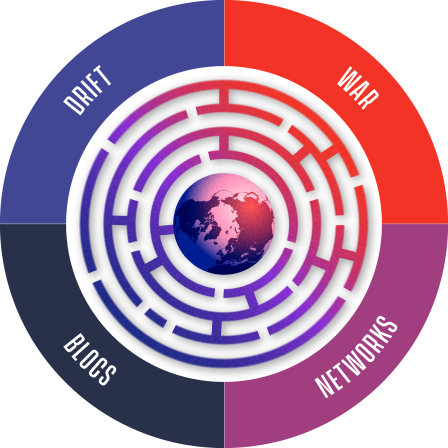
Four Scenarios for
U.S.-China Relations
and Their Impact on the Global Order to 2035
These scenarios were developed using Reos Partners’ Transformative Scenario Planning method, which is based on a process including interviews with participants, an in-person meeting to generate scenarios, and an iterative process of editing to arrive at consensus scenarios.
This project was sponsored by PAX sapiens and was organized by PAX sapiens, Grandview Institution, and Reos Partners.
DRIFT
RELATIONSHIP
Continuous tension
ECONOMY
Impeded growth and higher volatility
POLITICS AND SECURITY
Persistent distrust and high risks
TECHNOLOGY
Disordered decoupling
WAR
RELATIONSHIP
Hostility
ECONOMY
Economic devastation
POLITICS AND SECURITY
Armed conflict
TECHNOLOGY
Militarization of technological development
BLOCS
RELATIONSHIP
Strategic disengagement
ECONOMY
Asymmetric slow growth
POLITICS AND SECURITY
Two blocs
TECHNOLOGY
Separate systems
NETWORKS
RELATIONSHIP
Uneasy coexistence
ECONOMY
Acceptance of slower growth with more predictability
POLITICS AND SECURITY
Multipolar world
TECHNOLOGY
Disengagement in emerging technologies

Drift
Ongoing friction and contestation across many fronts.
In the Drift scenario, the U.S.-China relationship drifts from crisis to crisis. Trade cases are brought in international fora, and the U.S. and China contest disagreements in many different institutions. The South China Sea remains a flashpoint, with naval operations increasingly close to each other, and both the U.S. and China remain competitively focused on economic growth and military security. When crises arise, they are managed through on-the-brink diplomacy.
War
A series of escalating tensions during the next decade leads to a war between the two countries.
The War scenario explores how the kinetic conflict that is the fear behind much of the discourse today could actually happen. Increasing U.S. commitment to Taiwan and increasingly bellicose rhetoric from the Chinese Mainland harden positions, until the Mainland demands negotiations about reintegration under threat of conflict. Facing rising nationalist pressures in the U.S., Taiwan, and Mainland, none of the actors involved can back down from a cycle of escalating political conflict in which an accident sparks a military conflict.
Blocs
The formation of competing geopolitical blocs, acting to oppose each other across the military, economic, and diplomatic domains.
In Blocs, initial steps towards de-coupling and the formation of new economic and diplomatic alliances by the U.S. and China aimed at opposing the other side spin into an increasing cycle of separation and exclusion. By 2035, the world is split into new coalitions with some countries and regions trapped between the opposing blocs. The result is a world with unclear global rules and fragmented supply chains, complicated by regular diplomatic confrontations. Cooperation on global issues fragments, and the global commons is a source of contention.
Networks
The two countries selectively decouple, but global cooperation is maintained through complex networks.
In Networks, the decoupling processes continue, with both countries increasingly separating from the other. However, diplomacy and a recognition of mutual interests allow both countries to remain engaged with third parties and in discussion with each other through intermediaries and international institutions. This mediated communication leads to successful resolution of crises in third countries, with the U.S. and China supporting global systems, and eventually creates the context for direct crisis management when accidents involving U.S. and Chinese militaries demand it.
Methods note
These scenarios were developed using Reos Partners’ Transformative Scenario Planning method, which is based on a process including interviews with participants, an in- person meeting to generate scenarios, and an iterative process of editing to arrive at consensus scenarios. This project was sponsored by PAX sapiens and was organized by PAX sapiens, Grandview Institution, and Reos Partners.
The twenty-five Scenario Team members included a variety of people with experience working on the U.S.-China relationship: on the U.S. side, senior officials from the Trump and Obama administrations as well as investors, NGO professionals, and academics; and on the Chinese side, think-tank representatives, academics, and retired senior research fellows from the PLA. Because these scenarios describe four different possible futures, almost every Scenario Team member disagrees with elements of at least one of the scenarios. As a consequence, these scenarios represent not a consensus on implicit policy recommendations, but a series of compromises over many drafts by a group of diverse, committed, and caring professionals who worked together in the hope that these scenarios might encourage a dialogue that would promote peace and prosperity through an improved U.S.-China relationship.
